
13 minute read
IntroductiontoMaserati
Internallights
Day/night condition
Thisis determinedby:
-the light switch
-“night condition”detected by the vehicle’s twilightsensor.
-Therefore the activation of the position lights does not necessarily determine the activation of the internal lights.
Timing
3 minutes: Step lights under the door, and front and rear central ceiling lamps.
15 minutes: Glove compartment light, diver’s glove compartment light, sun visors' light, spotlight, front and rear central ceiling lamps if activated with the local control or by the inertia switch.
20 minutes: Luggage compartment light.
Externallights
Lights managed by the twilight sensor (AUTO mode): The external lights are activated automatically by the twilight sensor. From the NIT user menu, the driver can set the twilight sensor’s sensing level (3 levels).
’Followme home’:
Control enabling the position lights and low beams to switch on automatically for a timed period immediately after the vehicle is switched off (Key-OFF).
Activation: After Key-OFF, the flash lights control on the steering column stalk must be pressed. The instrument panel activates the ‘follow-me-home’signal and displays the time (in seconds) during which the lights will remain switched on. (Signal active for 20 sec.)
Activationtime increase: when the function is active, every time the flash lights control is pressed, the time the lights remain switched on is increased by a further 30 seconds (max. 210 sec.)
Deactivation: keep the flash lights control activated for over 2 seconds, then switch the ignition key from OFF to ON.
Front seats
Seat controls:

1. Adaptive (only on seat base)
2. Massage ON/OFF
3. Seat base shifting/tilting

4. Memories
Memorisation:
5. Seatbackangles/height
6. Ventilation
7. Heater
8. Lumbarsupportadjustment
With the three buttons (4) the user can store three different combinations of the following positions:
•Seat position
•Steeringcolumnposition
•External rear view mirror position
The position combination is stored by pressing one of the three buttons for over 3 seconds.
To confirm a successful memorisation, the ECU sends the message via the CAN network to make the confirmation buzzer sound.
Heating:
The seats are designed with a heating pad stitched onto the lining of the seat back and the cushion’s central sections.
Ventilation:
The seats are built with a "forced" ventilation system with three levels of speed, operated by two brushless fans, controlled by an ECU.
A.Ventilated areas
1. Axial fans 80 x 80 mm
4-way lumbar support adjustment: The front seats are standard equipped with electropneumatic lumbar support adjustment. The adjustmentat point Xis carried out by inflating the lower bag (1) (the larger one). The adjustmentat point Zis carried out by inflating the upper bag (2) (the smallerone)
The two bags, which partially overlap, are located between the padding and the support membrane.
Electro-pneumatic system: An optional electro pneumatic adjustment system is available for the front seats. This system is composed of six inflatable plastic bags, an air compressor and an ECU with integrated solenoid valves.
This system operates the 4-way lumbar support adjustment, self-adaptive and massage functions.
The self-adaptivefunction, ensures the seat provides its occupant with the optimum support regardless of the person’s shape and size. Action: all bags are inflated to maximum pressure; subsequent and sequential deflation until the same pressure is obtained throughout the complete system. Thiscycleis repeatedevery4 minutes.

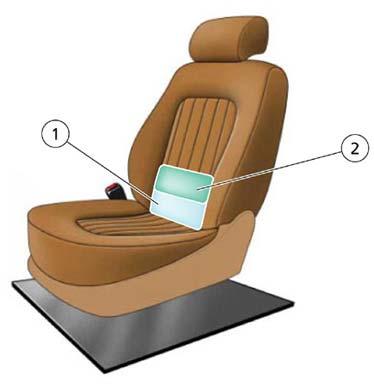
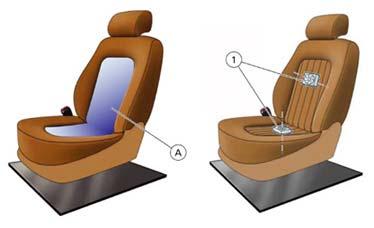
This function is activated by pressing the corresponding button and it is switched off by pressing the same button again.
1.Three partially overlapped bags located between the padding and the support membrane
2.Seat base side bags are located inside the padding.
Quattroporte
Massage system:
The massage functioninflates and deflates the following bags in sequence:
Thigh/ lowerlumbar/ centrallumbar/ upper lumbar/ thigh
The repetition interval lasts approximately a minuteand dependson:
•whether the maximum pressure is reached
•the time the pressure is kept constant.
The massage cycle lasts five minutes in total, after which the function cuts out and the previous settings are restored.
Rearseats
The rearseatsare fitted with seatbacks engineered to guarantee the occupantsthe maximum safety in the event of a collision.
Headrest: two side rests with adjustable heights and tilting movement, and one central rest, which can be power tilted and then reset manually by the driver.
Armrest: can be folded-down and opened. Insideits compartment one will find:
-12V socket,
-front passenger seat sliding control (on all versions),
-control switches for heating (Winter Pack and Comfort version) and for lumbar support adjustment, massage and ventilation (for Comfort version).
Parking sensors
The vehicle has two possible types of equipment for assisted parking: rearparking sensorsonlyor frontand rear parking sensors.
N.B: The typology of the ECU supplied changes depending on the vehicle equipment
The driver is alerted about the presence/distance of the obstacle by means of warning signals from:
-a rearbuzzer-for vehicles equipped with rear parking sensors;
-two buzzers, one at the front and one at the rear -for vehicles equipped with front and rear parking sensors
The frequency of the beeps also depends on how far away the obstacle is.
The front sensors (when fitted) are activated/deactivated with the specific button on the control plate on the lefthand side of the steering column.

1.Front
2.Rearbuzzerposition
Ultrasonissensors:
The sensoris anultrasound transducer, whichactsasa smart transmitter and receiver of ultrasound pulsepackages. The pulses emitted are reflected off any obstacles there may be; so the transducer receives an echo which is amplified and converted into a digital signal, then sent to the ECU. Each sensor can also operate as a receiver only, so that it can perform a triangular measurement between two sensors. This technique provides a better detection of small obstacles and in situations where reflection is critical.
IntroductiontoMaserati
The front sensorsare activatedunder the followingconditions: -key ON,
-vehicle speed below 15 km/h, -deactivation button in OFF position.
The rear sensors are activated in the following condition: -key ON, -reverse gearengaged.
The front or rear buzzers start to beep as soon as an obstacle is detected and continue to beep with increasing frequency as the vehicle nears the obstacle.
Operatingprinciple:
•The Electronic Control Unitcontrolsthe sensors(10 measuring processes per second).
•The signal, reflected off any obstacles, is intercepted by the sensor andsent to the ECU in digital form.
•The ECU compares the signal emitted with the one received and calculates, the time that elapses between the emission of the signal and the reception of the echo (transit time).
•This information is translated into distance and passed on to the driver in the form of beeps. The measurement accuracy is ±1 cm. A comparison with the previous measurements allows the system to establish whether the obstacleis getting nearer or further.
Note : a continuous beep indicates the obstacle is less than 30 cm away.
Recovery strategies:
•The system must be capable of automatically identifying any failures occurring during operation.
•Error whichdoes not jeopardisethe overall system operation: the system continues to operate.
•Error whichjeopardisesoperation or performance reliability: the system cuts out automatically and sends out an error message, indicated on the instrument panel (both visually and audibly)
IntroductiontoMaserati
Heating, ventilationand air conditioning(HVAC) the air conditioning and heating system allows the user to adjust the temperature and humidity within the passenger compartment. Its main components are:
1. Compressor
2.
3.
4.
5.
6.
Evaporator
Anti-pollenfilter
Heaterradiator
The refrigerant used is R134a.
The system is filled with 1100 ±25 g fluid
The oil used is UconRL897 Oil
The system is filled with:150 ±10 cc oil
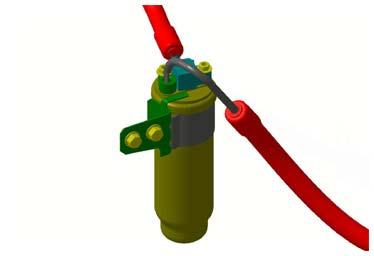
Descriptionof components:
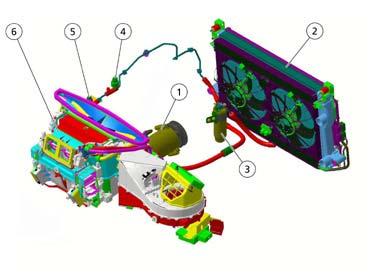
Compressor:
The variable piston compressor (1) makes it possible to change the coolant flow to the evaporator gradually.It is driven directly by the crankshaft by means of a Poly-v belt (2) and activated by an electro-magnetic clutch.

Dehydrator / filter:
The dehydrator / filter is connected to the condenser outlet and to the evaporator inlet.It performs the following functions:it filters any impurities in the coolant (which contains oil particles from the compressor), it separates the fluid to eliminate any humidity, it works as a reservoir for the coolant.
Multi levelpressuresensor(4 levels):
Thissensorcontrolsthe system operation, it controls the compressor and cooling fan activation/deactivation:
1st level(approx. 2,5 bar): minimum pressure enabling the compressor activation;
2nd level(approx. 15 bar): pressure requiring the activation of the electric fan’s first speed;
3rd level(approx. 20 bar): pressure requiring the activation of the electric fan’s second speed; 4th level(approx. 27°bar): max. pressure deactivating the compressor.
Expansion valve:
This valve regulates the flow and expansion of fluid R134a at the evaporator’s inlet. Inside the valve, the coolant is subject to a sudden and sharp pressure and temperature drop
Front air distribution unit:
This is the housing within which, the external (or recirculationair) is conditioned/heated and distributed to the vents selected by the user. Thisunitcontains:
Air flaps
Evaporator: thisisa heatexchangerhousedinside the air distribution unit. It is used to take off heat and humidity from the air conveyed to the passenger compartment. This is obtained by means the change in the coolant status –from liquid to gaseous –which takes place inside it.
Heater radiator: this is a heat exchanger connected to the engine cooling circuit by means of two lines: one line sucks warm water from the engine, the other returns the coolant to the engine. The heater is used to provide the heat required to warm up the air conveyed to the passenger compartment.
Flap actuators.
Air temperature sensors.
Anti-pollen filter: this is a combined air filter for the passenger compartment: particle + active carbon filter. It is used to filter the air entering the passenger compartment. The first filter layer (particle) prevents pollen and polluting particles from entering the passenger compartment; the second layer (active carbons) reducesnasty smells due to the humidity on the filter surface)
Electric fan: this is operated by a brushless electric motor, 12V power supply, and can be controlled at different speeds by a signal coming from the NCL (HVAC control module). It is housed inside the air conditioning/heating unit, next to the evaporator
Air pollution sensor:
When the air pollution level exceeds the preset harmfulness thresholds, the recirculation flap closes the external air inlet and the NCL (HVAC control module) activates the recirculation of inside air.When the air pollution level goes back to acceptable preset values, the flap opens the external air inlet once again and the NCL deactivates the recirculation of inside air.This sensor is fitted in the external air inlet on the air distribution unit on the first generation models. From MY06 onwards, the location of this sensor has moved to the radiator housing.
The demisting sensor:
When the windscreen misting level exceeds the preset thresholds,the recirculation flap opens the external air inlet cutting-out the AQS sensor signal.When the windscreen misting level goes back to acceptable preset values, the recirculation flap will get to the status requested by the system. It is fitted on the internal rear view mirror


Sun radiation sensor:
The sun sensor is used to measure the thermal energy generated by the sun radiation. It is positioned on the dashboard, next to the windscreen. This is a DUAL ZONE type sensor, to optimize the control of the dual air conditioning / heating system temperature.
External air temperature sensor:
This is a NTC sensor fitted inside the external rear view mirror, driver’s side. Its operating range is -40°C / 80°C.
Note: ForMY06 (assembly number21926 onwards), the software of the NCL module hasbeenmodifiedtoimprove performance.
Treated air temperature sensors: These sensors (1) are used to read the temperature of the air treated by the air conditioning/heating system before it is conveyed to the passenger compartment. The two treated air temperature sensors are positioned next to the central vents.
Passenger compartment temperature sensor: These sensors (1) are used to read the actual temperature inside the passenger compartment.This sensor is equipped with a tiny electric fan, fitted inside it. This fan is constantly powered, so that the temperature reading is not affected by any stationary air inside the dashboard.
Air mixing flap actuators
The treated air temperature is adjusted using the temperature setting buttons (1 and 2).
Air distributionactuators
The actuator moves the distribution flaps into the 5 possible positions.Main positions: DEF, VENT, FLOOR. Combined positions: BILEVEL, HEAT
Recirculationactuator
The recirculation actuator controls the flap rotation in the two threshold positions (dynamic air and air recirculation) without intermediate positions.
The HVAC control module (NCL):
This module is positioned on the right of the front passenger’s foot area, is fitted on the air conditioning/heating unit. It is connected to the low speed B-CAN network.The NCL receives the following information from the Body Computer (NBC) node, via CAN network:
-Outside air temperature
-Engine water temperature
-Engine Rpm
-Vehicle speed (tachometer signal)
-Battery voltage (battery charge status)
-Heated rear window activation
-Compressor status
-Vehicle light status.
IntroductiontoMaserati
ModificationsforMY07 and Quattroporte Automatic: Withthe introductionof the Quattroporte Automaticand MY07 (fromassembynumber 27860 onwards), a numberof importantmodificationsweremadetothe HVAC system in ordertoimproveitsperformance.

The amountof refrigerantgas and lubricationfluidhasbeenchangeddue toa modified dehydrator/ filter:
•Coolant: R134a PAG RL –897, the system of this vehicle is filled with 1050 ±20 g of coolant.
•Lubricant: the oil usedisUconRL897system is filled with: 200 ml ±10 ml of fluid.
Alsovariouspartsof the front air distributionunithavebeenredesignedor modified. The heatingradiatorisnew, aswellasthe anti-pollenfilter. The ventilationmotor isnew and is nowmore powerfullwhileitisat the same time lessnoisy. The NCL unithasnew software.
The air conditioning/heating system of the QuattroporteAutomatic and MY07 provides enhanced air flow obtained with new and suitably dimensioned air lines. Thanks to these modifications, the overall performance of the ventilation system has increased by 50% (370 m³/h instead of 240 m³/h previously).
Quattroporte
9. Bodywork
The Quattroporte usesa steel sheetmonococquebody structurein combinationwithtwo auxiliarysteel framestosupportthe powertrainand wheelsuspensions. The quattroporte’s floorplanhasbeenmodifiedwiththe introductiionof MY07 and Quattroporte Automatictohouse the new automatictransmission. Attachingpointswere addedforthe transmissionsupportand the centralsupportingbearingof the propellor shaftwhilethe transmissiontunnel wasenlargedtohouse the gearbox.
Central tunnel area modified to support the gearbox and propeller shaft

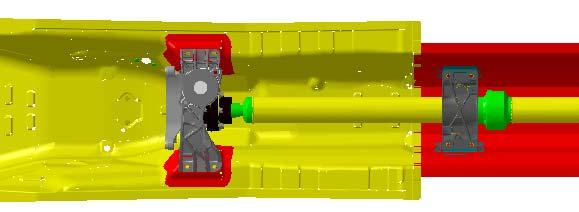

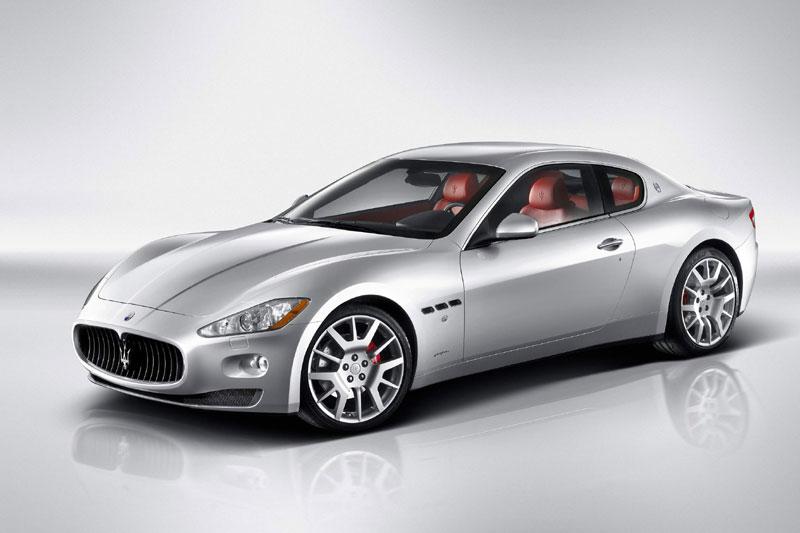
The new Maserati GranTurismo, introduced at the Geneva motor show in March 2007, is a technical spin-off of the QuattroporteAutomatic and reflects its power, stability and comfort features.
Its authentic and unmistakably Maserati style transmits an imageof power and elegance. Pininfarinahas tailor-made the sleek and sensual bodywork, developed around the GranTurismoproject idea: create a sports car yet with plenty of space to suit one and all.
From the large oval mouth that envelops the radiator grille right through to the rear, the bodywork sits on the mechanics like a tight-fitting dress on sinuous hips. The resulting powerful, trim and elegant shape arouses an emotion that only a timeless design can give. The elegant design of the interior, made warm and cosy by the quality materials and handmade finishes, embraces the passengers in a bright, comfortable and sporty atmosphere.
The new Maserati GranTurismosprings from the experience gained with the Quattroporte in the luxury car sector, and provides a unique implementation of those concepts that have made the model an unchallenged international success.
The new Maserati GranTurismohas the following features in common with the Quattroporte:
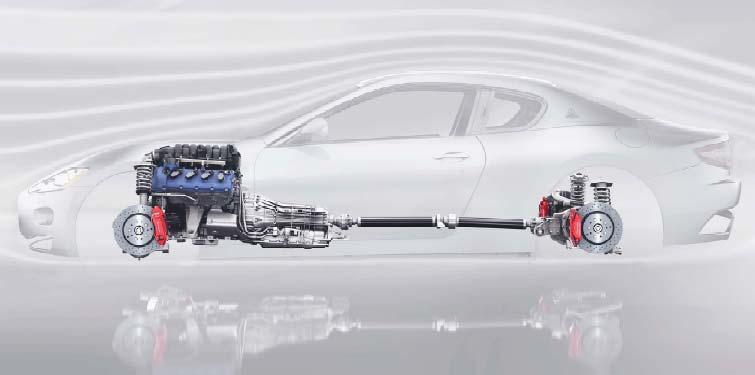
•the mechanical configuration designed to provide an emotional driving experience
•meticulous care in the choice of materials and equipment, aimed at creating a sophisticated and comfortable ambience.
•a complete range of customisation options so that the customers can express their own personality and satisfy their needs.
Dimensions, capacitiesand weights
Length: 4,881 mm
Width: 1,847 mm
Width: 2,056 mm
Height: 1,353 mm
Wheelbase: 2,942 mm

Front track: 1,586 mm
Rear track: 1,590 mm
Front overhang: 873 mm
Rear overhang: 1,066 mm
Luggage compartment capacity: 260 l
Fuel tank capacity: 86 l
Dry weight (UE version): 1,780 kg
Unladenweight (UE version): 1,880 kg
Kerb weight with driver (UE version): 1,955 kg
Maximum permitted weight: 2,180 kg
Technically permitted weight: 2,250 kg
Kerb weight distribution: 49% Front; 51% Rear
Vehicleperformances
Top speed: 285 km/h (at 7050 RPM in 5°gear)
Acceleration from 0 to 100 km/h: 5.2 s
Acceleration from 0 to 400 metres: 13.4 s
Acceleration from 0 to 1000 metres: 23.9 s (output speed 225 km/h)

Pickup from 80 to 120 km/h: 3.7 s
Stopping distance from 100 km/h to 0: 35 m
Weight distribution is one of the key reasons behind the stability and balance of the vehicle, which also enhances the safety features perceived whiledriving. The configuration designed for the GranTurismo was obtained by moving the engine assembly to behind the front axle which, in everyday driving, translates into smooth and predictable vehicle behaviour. This not only enhances comfort and handling but also maximises traction during acceleration and road holding. With respect to the QuattroporteAutomatic, overall vehicle performances have been improved, while fuel consumption has decreased (3%), notwithstanding the mechanical base is identical. This is thanks to the lower vehicle weight, improved aerodynamic efficiency (Cx: 0.33), specific software for engine and gearbox control, and aslightly shorter final drive ratio of the differential.
Fuel consumption and emissions (2004/3/EC directive)
City cycle: 21.58 (l/100 km)
Motorway cycle: 10.02 (l/100 km)
Average fuel consumption: 14.31 (l/100 km)
CO²emissions (average): 335.0 (g/km)
Scheduled maintenance
The scheduled maintenance program for the Maserati GranTurismois identical to the one for the Maserati QuattroporteAutomatic.
Towing the vehicle
If you need to tow the vehicle, observe the following recommendations: if possible, have the vehicle transported on a vehicle equipped with loading platform and specific for roadside assistance and recovery.
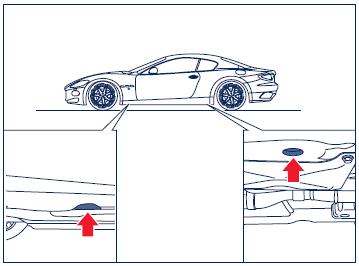
If this is not possible: tow the vehicle lifting the driving wheels (the rear ones). If this is not possible: tow the vehicle for a distance of less than 100 km at a speed below 60 km/h. Tow the vehicle using the towing hook found in the toolkit. Screw the towing hook down tightly in its seat, on the lower, right-hand side of the front bumper.
In addition, for towing you must engage Neutral by moving the gearshift lever to position N. Do not extract the key, as the steering wheel will lock automatically and you will be unable to steer the wheels. WARNING: If you have to tow the vehicle with 2 wheels raised, ensure that the ignition key is in the STOP position. Otherwise, with the MSP activated, the relative electronic control unit stores a malfunction and the warning light on both the instrument panel and the display will come on; the vehicle will have to be taken to the Maserati Service Network to have the malfunction corrected.
Lifting and jacking
Usethe theindicatedpointsonlyforlifting or jackingof the vehicle.
Maserati GranTurismo
1. Engine
The Maserati GranTurismouses a 4.2 90°V8 wet sump engine, code named F136UD. This engine is basically the identical to the engine used by theQuattroporteAutomatic (F136UC). Modifications were made only to the controlling sofware(different mapping), which gives the engine a slightly higher power output for the GranTurismoand more allert reactions to the commands of the accelerator pedal. This to enhance the dynamic characteristics of the vehicle.
The basic technical solutions of this new engine has been designed to obtain high specific power and to rapidly increase and decrease of the RPM, which is typical of competition engines, yet always with a watchful eye on fuel consumption, driving smoothness and silent operation.
The specific tuning of the V8 engine of the Maserati GranTurismo, unlike that of the engines used in the automatic versions of the Quattroporte, was aimed at improving the response to the accelerator commands (+20% in SPORT mode compared to the QuattroporteAutomatic). In this configuration, the engine reaches its maximum 405 HP at 7100 RPM (specific power of 96.4 HP/litre) and the maximum torque of 460 Nm at 4750 RPM, 75% of which is already available at 2500 RPM.
See chapter 3 “Mechanical Components”for more detailed information about this engine.
IntroductiontoMaserati
Engineperformance curves:

Max power: 297kW (405 HP) at 7100 rpm
Maximumtorque: 460 Nm(47Kgm) at 4750 rpm
Enginecontrol system:
The enginecontrol system and itsvariuoscomponentsof the GranTurismoisidenticalto the system of the Quattroporte withautomatictransmission. The usedenginecontrol system isBosch Motronic7.1.1; calibrationsoftware ishoweverspecificforthe GranTurismo.
On the nextpagesare onlydescribedthe systemsor partswhichhavebeenmodifiedfor the GranTurismo.
IntroductiontoMaserati
Air intake system:
The air intakesystem of the GranTurismohasthe samecharacteristicsasthe Quattroporte Automatic. The shapeof the front air ducthasbeenmodified and isthusspecificforthe GranTurismo.
Fuel system:
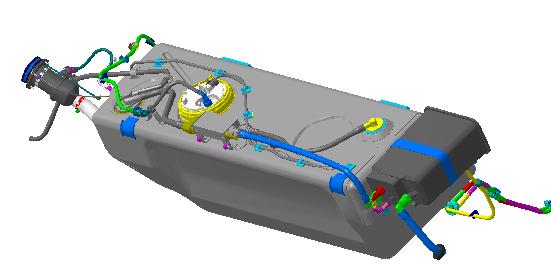
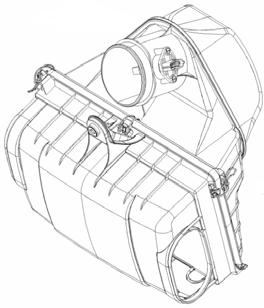
The fueland anti-evaporative system usedin the Maserati GranTurismohasthe same characteristicsasthe system usedin the Quattroporte.
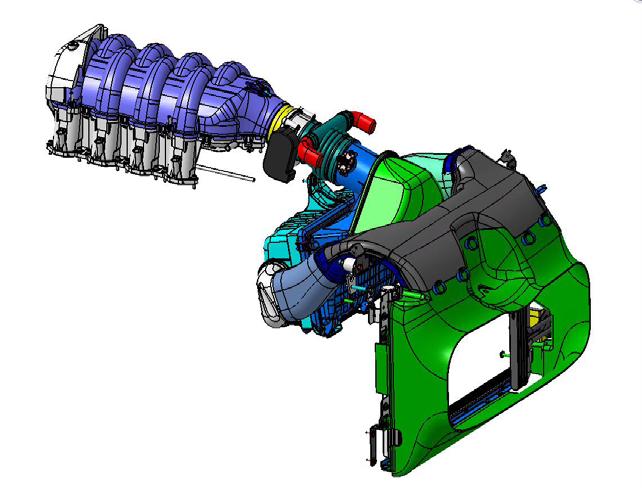
Inertiaswitch:
The opertionlogicand the location of the inertiaswitchin the GranTurismoisidenticaltothe Quattroporte. The differenceliesin the factthatthe inertiaswitchisat one side nowconnectedtothe body computer (NBC). The body computer willactivate the hazardlightsand the interior lightingand willunlockthe doorsin case a collisionisdetected.
Exhaust system:

The exhaustsystem of the Maserati GranTurismois derivedfromthe system used in the Quattroporte Automaticand hasthe same characteristics. The shapeof the system hasbeenmodifiedtofitthe GranTurismo’s floorplan. Tailpipesare specific.











